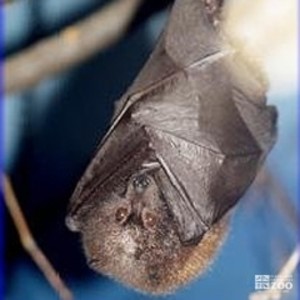Rodrigues Flying Fox
[Pteropus rodricensis]

The Rodrigues Flying Fox Bat is a medium-sized bat that is about 12 inches long. its coloration is silvery and blackish-brown. There is no tail. The area between the shoulders is often yellow or grayish-yellow. They maintain a body temperature of 96–104 degrees Fahrenheit (33–37 degrees C). They have a very noticeable characteristic odor.
They normally roost in trees by day, and colonies may utilize the same roosting site year after year. During daylight hours, the noise level and the amount of motion of other bats will cause some individuals to fly from one location to another that is less chaotic. The range is maintained by this constant activity.
At dusk they fly to fruit trees to feed. Some drink sea water, apparently to obtain mineral salts lacking in the plant food.
Location: The Lower RainForest
Share:
Range
The Rodrigues flying fox bat is found on Rodriques Island in the western Indian Ocean
Habitat
Rodrigues flying fox bats inhabit forests and swamps.
Conservation Status
EndangeredPrimary Threats
Human-Wildlife Coexistence, Climate Change. This species is endangered, and its future remains in doubt. They have been seriously affected by the clearing of forests, resulting in easier access by hunters, and loss of buffering protection against cyclonic winds. Captive breeding groups have been established to help preserve the species.Gestation
Gestation for the Rodrigues flying fox bat takes 140–150 days.
Litter
One pup. Independent at 6–12 months.Behavior
The Rodrigues Flying Fox Bat inhabit forests and swamps, often on small islands near coasts. They normally roost in trees by day, and colonies may utilize the same roosting site year after year. During daylight there is much noise and motion in the roosts, and individuals sometimes fly from one place to another. This range is maintained by constant activity. At dusk, they fly to fruit trees to feed. They eat, rest, and digest their food for several hours while at their feeding trees. The principal food is fruit juices, which they obtain by squeezing pieces of fruit pulp in their mouths. They swallow the juice and spit out the pulp and seeds. If the pulp is very soft, like banana, they swallow some of it. They also chew eucalyptus and other flowers to obtain juices and pollen. They drink while flying to and from the feeding and sleeping locations. Some drink seawater, apparently to obtain mineral salts lacking in the plant food. They maintain a body temperature of 33–37 degrees C. They have a very noticeable characteristic odor.
Reproduction
The breeding season is October through December. The bats mature between one to two years. The median lifespan is 30 years.Wild Diet
Fruit, eucalyptus and other flowers.

